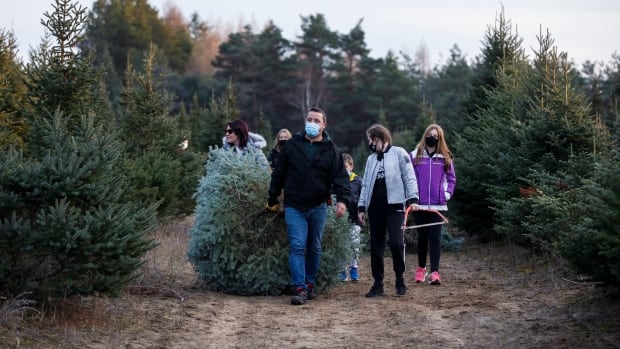
What On Earth5:03What on Earth listeners share green holiday hacks
Festive decorations and delightfully wrapped presents are a staple of the Christmas season, but they bring with them plenty of waste.
Household waste can increase by as much as 25 per cent around the holidays, according to non-profit organization Zero Waste Canada. And only one per cent of everything the average person buys is still in use after six months, the same report says.
That’s why environmentalists say it’s time to reduce — and reuse — around the holidays.
“If we get gifts from other people that have used wrapping paper, then the best thing to do is to keep using and reusing — and reusing and reusing — that wrapping paper over and over and over again for as long as we possibly can,” said Myra Hird, a professor in the School of Environmental Studies at Queen’s University in Kingston, Ont.
While foil- or plastic-based gift wrap is generally not recyclable, some paper gift wrap can go in the blue bin.
Gift wrap and shopping bags account for 545,000 tonnes of waste each year, Zero Waste Canada says.

“What I use is the tear test,” said Charlotte Ueta, a project director for the City of Toronto’s solid waste management division. “If you can tear the wrapping paper and it pretty much tears like a piece of paper, then that means … that can go in the recycling bin.
“But if you tear it and it’s full-on … metallic or it’s kind of attached with a plastic liner, that would go in the garbage.”
The 3 Rs of the holiday season
Recycling programs vary from one municipality to the next — for example, Toronto accepts Styrofoam in its recycling bins, while other programs don’t — so Ueta recommends checking a region’s specific rules.
For those who want to avoid wasteful packaging, Hird offers a different approach. Cloth wrapping can be a clever alternative, she said, while wrapping in paper grocery bags offers Sound of Music-inspired “brown paper packages tied up with string.”
But what goes inside that paper is just as important. Both Hird and Ueta say it’s important to consider the source of the gifts you give.

Brand-new items have a higher carbon footprint than something used. Ueta says one option to consider is giving experiences, such as a special meal, rather than products.
When it comes to Christmas trees, the reduce, reuse, recycle mantra remains true. If you’re putting up a real tree, for example, that could mean composting it or giving it a second life.
“If you have a wood chipper in your backyard, you can chip in and make mulch out of it,” said Robert Henri, director of communications and marketing at Tree Canada, a non-profit committed to planting and nurturing trees.
Certainly, not everyone has a wood chipper to fire up. Many municipalities will collect trees after the festive season and take care of the mulching for you.
Ueta says that in Toronto, that mulch goes through a process known as aerobic composting, where it’s mixed with oxygen until it eventually becomes compost.
“Renewable” natural gas, a byproduct of the composting process, is also used to fuel the city’s waste vehicles.
Every year, thousands of Christmas trees are bought, displayed and then thrown away. But one Edmonton-area tree farm is doing things another way. Farlinger Farms rents out pine and spruce trees for the holidays. The trees will return to the farm before eventually getting planted in people’s yards.
If you want to preserve the life of the tree, Henri says that leaving it in your backyard can provide a home to small critters through the winter. It can also be used to beautify community spaces, such as around a skating rink or along a walking trail.
“Trees have been proven to lower stress and … can help you better manage mental health issues,” he said.
Real or fake Christmas tree?
As for choosing the type of tree you use to deck the halls, Henri says that living trees typically beat out artificial trees.
If they’re grown responsibly, real trees have the benefit of absorbing carbon from the atmosphere and providing habitats for woodland creatures, he says. They also clean soil and water, and help prevent erosion around waterways.
While an artificial tree can be used year after year, Henri says it can require up to 20 uses before its production becomes carbon neutral.

“An artificial tree is obviously made from plastic; most of the time it’s made with a lot of toxic chemicals,” he said. “Usually these are manufactured overseas, so the cost of actually shipping the tree over here has an impact.”
Henri recommends finding a nearby tree grower and, if possible, relying on delivery, which can be more efficient than driving to a tree farm.
‘Be mindful of what you purchase’
Properly disposing of holiday waste — whether it’s crinkly gift wrap or an eight-foot spruce — is important to divert as much as possible from the landfill, Ueta says.
When non-recyclable material ends up in the blue bin, it has to then be treated as contamination and sent to a landfill. That means your waste is, essentially, being processed twice.
And tossing organic materials into the trash also means that more waste ends up in landfills, which emit methane.
Though proper recycling is a key part of reducing the impact of waste around the holidays, Ueta says it’s important to consider reducing consumption overall.
“Be mindful of what you purchase, what you consume, because obviously creating new things [and] materials requires new sources,” she said.
“You want to try to keep the materials in cycle in a system as much as possible to reduce the amount of natural or raw material being used to generate new products.
